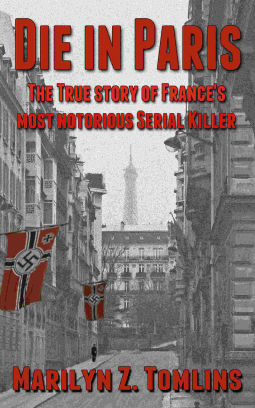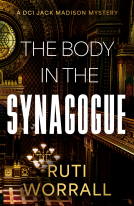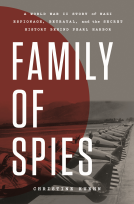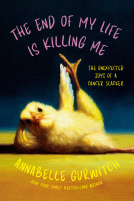
Die in Paris
The true story of France's most notorious serial killer
by Marilyn Z Tomlins
This title was previously available on NetGalley and is now archived.
Send NetGalley books directly to your Kindle or Kindle app
1
To read on a Kindle or Kindle app, please add kindle@netgalley.com as an approved email address to receive files in your Amazon account. Click here for step-by-step instructions.
2
Also find your Kindle email address within your Amazon account, and enter it here.
Pub Date Aug 23 2013 | Archive Date Jul 31 2019
Talking about this book? Use #DieInParis #NetGalley. More hashtag tips!
Description
Marcel Petiot, France’s most famous serial killer
A spring night in Paris. The most beautiful city in the world is dark and silent. Uncertainty devils the air. As does normality: war time normality. The Nazis’ Swastika flutters from the Eiffel Tower. The Parisians are huddled indoors. Suddenly the night’s stillness is shattered by sirens and excited voices. For days foul smoke has been pouring from the chimney of an uninhabited house close to the Avenue des Champs-Elysées. Police and firefighters are racing to the house to break down the bolted door. They make a spine-chilling discovery. The remains of countless human beings are being incinerated in a furnace in the basement. In a pit in an outhouse quicklime consumes still more bodies. Neighbors say they hear banging, pleading, sobbing and cries for help come from inside the house deep at night. They say a shabbily-dressed man on a green bicycle pulling a cart behind him comes to the house, always at dawn, or dusk. The house belongs to Dr Marcel Petiot – a good-looking, charming, caring, family physician who lives elsewhere in the city with his wife and teenage son. Is he the shabbily-dressed man on the green bicycle? If so, what has he to say about the bodies? Die in Paris will give you new insights into the horrors of Occupied France.
Advance Praise
Marilyn Z. Tomlins has crafted an enthralling and suspenseful page-turner about one of history's most fascinating and notorious serial killers. This grisly World War Two era thriller will have you teetering on a slippery edge from beginning to end.
Don Fulsom, veteran UPI and VOA White House correspondent, Washington, D.C. reporter, author of the bestseller Nixon’s Darkest Secrets: The Inside Story of America’s Most Troubled President, and a professor of government at American University in Washington.
With style, Marilyn Z. Tomlins’ Die in Paris, tells the incredible story of France’s most prolific murderer. Readers will discover a truly psychotic serial killer.
J. Patrick O’Connor, author of the bestsellers The Framing of Mumia Abu-Jamal and of Scapegoat: The Chino Hills Murder and the Framing of Kevin Cooper, and the creator and editor of www.crimemagazine.com
Marketing Plan
Proposal for a one-off dramatized television documentary based on the true-crime book ‘Die in Paris’ by Marilyn Z. Tomlins
Knowing the story of Marcel Petiot as I do, I am sure it lends itself to a filmed documentary treatment. I also evince the obvious: that there will be a multi-demographic appetite for a big screen movie. If probed with an ideal balance of scientific objectivity and dramatic flair, bestial human behaviour can be bleakly fascinating. This one is not only a tale of sheer horror, but it also carries a political message: what the consequences are when a nation does not resist aggression from another nation, in other words, when it capitulates to an enemy. It also offers an opportunity to debate capital punishment. Although I suffered no illusions as to Petiot’s crimes, I could not help to feel immense sympathy for him in the final moments of his life when he was led to the guillotine. I reminded me of Sean Penn in ‘Dead Man Walking’. Another major draw is Petiot’s physical attractiveness, and not only his, but that of his brother Maurice and of Georgette, his wife. Petiot looked like Johnny Depp and Georgette was typically Parisian – petite, mignonne (slender and cute) and chic. Audrey Tautou (she was in The Da Vinci Code) and Juliette Binoche come to mind. There is also the fact that this story did not take place in a backwater village or one of Paris’s poorer arrondissements. It happened in the capital’s wealthiest, most beautiful area – the Champs-Elysées/Étoile district with the Eiffel Tower visible at the end of Rue le Sueur where the murder house stood at Number 21. The life and crimes of similar characters – Crippen, Bundy, Jack the Ripper et al –have been examined at length in the TV documentary format and on the big screen, however, the life and crimes of the good ‘Doctor’ Marcel Petiot have not. Why? Mainly because the French still can’t come to terms with how they had capitulated to Hitler and his Nazis and had then collaborated with them, even rounding up people to be sent to the death camps. These days they blame their collaboration and the Occupation on ‘Vichy’, as if Vichy was some creature from outer space. The French therefore do not want to speak of Petiot. In fact, so difficult is it to research Petiot that the last books about him in English before my ‘Die in Paris’ were published in 1980 – 36 years ago.
Available Editions
| EDITION | Paperback |
| ISBN | 9780992670009 |
| PRICE | £12.99 (GBP) |
Average rating from 13 members
Featured Reviews
 Hilary W, Reviewer
Hilary W, Reviewer
author writes the tale because she found him “ghoulishly fascinating” – she “does not analyse or judge him” just "leaves the reader to make up their own mind”. I had never heard of the man before – but reading this book which recounts how a full blown psychopath operated in plain sight for years unchecked is like watching the proverbial train crash in slow motion.
In March 1944 police receive reports of dreadful burning smells coming from an empty building. Things are sensitive it lies next door to a Gestapo garage in occupied Paris. 2 police investigate and find the house strewn with partly opened suitcases with clothes and belongings and in the back area they discover human body parts being burnt, more in a pit covered in quick lime and others in heaps. They report it – and then decide to strategically disappear until after the war.
With German permission the situation will be investigated and a daily account is given here of the police attempts to determine what has been going on and who the (possibly hundreds of) bodies were. Various claims are made of killing of collaborators and Gestapo spies, but it becomes clear that it was a house used for some years in a mock “escape line” used by rich Jews, career criminals and others as the German grip on the City became tighter. The early victims were dumped elsewhere, but ironically as Dr Petiot was imprisoned by the Gestapo bodies began to build up in the house so by 1944 attempts were made to get rid of them.
Flash back to the early life of Dr Petiot – his early childhood abusing animals, erratic and violent behaviour, service in WW1 until he was apparently injured and used “shell-shock” to get himself out of the front line and into a war pension. Life in asylums morphed into supposed training (not) as a doctor. He sets up a rural practice leaving a trail of missing inconvenient people and on to Paris to set up a successful practice where it seems he was involved in illegal practices, tax avoidance, drug misuse and more deaths before he moved onto “greater” extremes.
By the time the reader reaches details of the trial of 27 murders – more boasts Petiot – it is increasingly hard to process the extent of what was happening, the casual extinction of dozens of people. But also the number of people who knew what was happening and did nothing to stop it.
It is clear from the research that whenever challenged he proved both an unscrupulous and extravagant liar. But nevertheless got away with his crimes again and again. Together this makes an extraordinary tale of a violent psychopath killing without constraint or restraint. He was identified as mentally unstable a number of times; but always left free to operate. Often with the collusion of family and associates who must have understood at least part of what he was doing.
You could read this as a classic of the failure of systems to record, identify, or prevent crime over many decades – a justice system that was patently flawed and unfit for purpose. But with the Second World War the new “rules” meant that Dr Petiot had even more opportunities to flourish as an amoral criminal. Yes, he tried to avoid conviction and execution by a combination of lies, bluster and counter attacks when caught. But as he said under investigation against the scale of the killings elsewhere where was his crime?
Overall this is a strange read – peering into the depths of a psychopath. But behind that is the history of failure of legal and police procedures that allowed him to thrive for so long. He lived within broader communities that also failed to prevent his behaviour as it became more and more extreme. It could be said that both the wars have him the chance to flourish and escape justice, but analyse the evidence and you might find it much more than that.
Die in Paris is an exhaustive look at a heinous killer in France. Tomlins provides excruciating details into the macabre murders performed by the doctor, who appeared as an average citizen. Almost too detail is given. Sometime I felt as if I were swimming in a sea of facts. It was Interesting to read the details of his execution by guillotine.
 Brenda M, Reviewer
Brenda M, Reviewer
One of the most atrocious crimes occurring in occupied France was revealed on the evening of Saturday, March 11, 1944. A constant rolling of smoke from an empty house on one of the best streets in Paris was revealed to be from the biting of tens of corpses. The criminal-an attractive doctor by the name of Petiot with a history of mental defect. As a boy he showed all the signs of a serial killer: bed wetting, starting fires, animal cruelty, parental dysfunction was high. What made his crime all the more despicable was he claimed to be with the Resistance. I thoroughly enjoyed this book. I especially love anytime I can read a recounting of a French court case! It's so unlike the United States. Tomlins was very detailed in her narrative. I appreciated her involvement. I felt like telling this tale was a part of her life for quite some time. I don't see how she could have left anything out. Excellent job!
Die in Paris was a very interesting read about an individual I had never heard of. I enjoyed reading about Petiot's childhood and upbringing and how that shaped him into the awful man that he was.
Thank you to Netgalley and Raven Crest Books for this ARC!
 Cristie U, Book Trade Professional
Cristie U, Book Trade Professional
The author's painstaking research and attention to detail is obvious in the writing of this book. The author laid out the information in a manner that allowed the reader to form their own opinion.
 Reviewer 343665
Reviewer 343665
Engrossing, scary. Nicely written, keeps you wanting more. Written in a logical and methodical manner, it fills in the reader with as much real time history as necessary to understand how it was when Nazis ran Paris (temporarily). The killer takes full advantage. Many of his victims were wealthy (or not) Jews who were roped in expecting to pay, and then be transported out of there before it was too late. But it was already too late because this Parisian monster took the money, furs, jewels and then took their lives.
Readers who liked this book also liked:
Kim Hana; Hwang Sunwoo
Biographies & Memoirs, Nonfiction (Adult), Parenting, Families, Relationships
Annabelle Gurwitch
Biographies & Memoirs, Health, Mind & Body, Humor & Satire
Benjamin Reynaert
Arts & Photography, Home & Garden, Reference


















